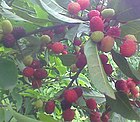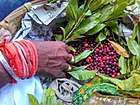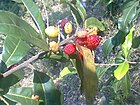Note: This is a project under development. The articles on this wiki are just being initiated and broadly incomplete. You can Help creating new pages.
Difference between revisions of "Myrica esculenta - Katphala"
(→External Links) |
|||
| Line 93: | Line 93: | ||
==External Links== | ==External Links== | ||
| − | * [https://easyayurveda.com/2017/06/21/box-myrtle-katphala/ Myrica esculenta | + | * [https://easyayurveda.com/2017/06/21/box-myrtle-katphala/ Myrica esculenta on Easyayurveda] |
* [https://uses.plantnet-project.org/en/Myrica_esculenta_(PROSEA) Myrica esculenta on planet project.org] | * [https://uses.plantnet-project.org/en/Myrica_esculenta_(PROSEA) Myrica esculenta on planet project.org] | ||
* [http://www.ijpsonline.com/articles/a-review-on-ethnomedicinal-phytochemical-and-pharmacological-aspects-of-imyrica-esculentai-3422.html?view=mobile A Review on Ethnomedicinal, Phytochemical and Pharmacological Aspects of Myrica esculenta] | * [http://www.ijpsonline.com/articles/a-review-on-ethnomedicinal-phytochemical-and-pharmacological-aspects-of-imyrica-esculentai-3422.html?view=mobile A Review on Ethnomedicinal, Phytochemical and Pharmacological Aspects of Myrica esculenta] | ||
[[Category:Herbs]] | [[Category:Herbs]] | ||
Revision as of 16:59, 1 November 2018
Katphala is a small tree or large shrub native to the hills of northern India and Nepal. It is found in hilly regions of northern India and Nepal especially in the regions of Garhwal and Kumaon of Uttarakhand and western Nepal especially at elevations between 3,000 and 6,000 feet. It is also found at elevations below 1500 m in the midhills of Nepal.
Contents
- 1 Uses
- 2 Parts Used
- 3 Chemical Composition
- 4 Common names
- 5 Properties
- 6 Habit
- 7 Identification
- 8 List of Ayurvedic medicine in which the herb is used
- 9 Where to get the saplings
- 10 Mode of Propagation
- 11 How to plant/cultivate
- 12 Commonly seen growing in areas
- 13 Photo Gallery
- 14 References
- 15 External Links
Uses
Fevers, Asthma, Coughs, Rheumatism, Cholera, Blotches, Pimples, Catarrh, Dysentery
Parts Used
Chemical Composition
The fruits of Myrica nagi are known for their ravishing taste and have been reported for reducing sugars, tannins and Vitamin C22, 23. Gallic acid, catechin, chlorogenic acid and ρ–coumaric acid in the ethanolic extract of the fruits24 were examined by HPLC analysis, it scavenge 2,2’-azinobis(3-ethylbenzoline-6-sulphonic acid) radical (ABTSc+) and 1,1-diphenyl-2-picrylhydrazyl radical (DPPHc+) and reduce ferric ion.[1]
Common names
| Language | Common name |
|---|---|
| Kannada | NA |
| Hindi | Kaiphal, Kaphal |
| Malayalam | NA |
| Tamil | Cavviyaci, Cavviyacimaram |
| Telugu | NA |
| Marathi | NA |
| Gujarathi | NA |
| Punjabi | NA |
| Kashmiri | NA |
| Sanskrit | Katphala, Mahavalkala |
| English | NA |
Properties
Reference: Dravya - Substance, Rasa - Taste, Guna - Qualities, Veerya - Potency, Vipaka - Post-digesion effect, Karma - Pharmacological activity, Prabhava - Therepeutics.
Dravya
Rasa
Tikta (Bitter), Kashaya (Astringent), Katu (Pungent)
Guna
Laghu (Light), Tikshna (Sharp)
Veerya
Ushna (Hot)
Vipaka
Katu (Pungent)
Karma
Kapha, Vata
Prabhava
Habit
Identification
Leaf
| Kind | Shape | Feature |
|---|---|---|
| Simple | oblong | The leaves are divided into 3-6 toothed leaflets, with smaller leaflets in between |
Flower
| Type | Size | Color and composition | Stamen | More information |
|---|---|---|---|---|
| Unisexual | 2-4cm long | Yellow | 5-20 | Flowers Season is June - August |
Fruit
| Type | Size | Mass | Appearance | Seeds | More information |
|---|---|---|---|---|---|
| sessile | 7–10 mm | The tree yields a drupaceous fruit which is one of the tastiest wild fruits of the sub-Himalayan region | sepals and petals, either absent or not visible | many | {{{6}}} |
Other features
List of Ayurvedic medicine in which the herb is used
- Vishatinduka Taila as root juice extract
Where to get the saplings
Mode of Propagation
How to plant/cultivate
Prefers a moist soil. Grows well in an open position in a well-drained soil in sun or light shade[3]
Commonly seen growing in areas
Open mixed forests, mountain slopes.
Photo Gallery
References
External Links
- Ayurvedic Herbs known to be helpful to treat Fevers
- Ayurvedic Herbs known to be helpful to treat Asthma
- Ayurvedic Herbs known to be helpful to treat Coughs
- Ayurvedic Herbs known to be helpful to treat Rheumatism
- Ayurvedic Herbs known to be helpful to treat Cholera
- Ayurvedic Herbs known to be helpful to treat Blotches
- Ayurvedic Herbs known to be helpful to treat Pimples
- Ayurvedic Herbs known to be helpful to treat Catarrh
- Ayurvedic Herbs known to be helpful to treat Dysentery
- Herbs with Bark used in medicine
- Herbs with Fruit used in medicine
- Herbs with common name in Kannada
- Herbs with common name in Hindi
- Herbs with common name in Malayalam
- Herbs with common name in Tamil
- Herbs with common name in Telugu
- Herbs with common name in Sanskrit
- Herbs with common name in English
- Habit - Herb
- Index of Plants which can be propagated by Seeds
- Index of Plants which can be propagated by Cuttings
- Herbs that are commonly seen in the region of Open mixed forests
- Herbs that are commonly seen in the region of mountain slopes
- Herbs







